Logitech MX Revolution: New Technology means a Smarter Mouse
by Gary Key on September 28, 2006 1:00 AM EST- Posted in
- Peripherals
Design
The MX Revolution's most prominent design feature is the integrated thumb rest area. While other mice might have a similar area for the thumb or grooved recesses, the sculpted curve design of the Revolution feels perfectly natural. This entire area is molded with a rubber grip that has a nice tactile feel to it. While the number of buttons first appears to be minimal, the layout design conceals the fact that there are nine available button/wheel choices. The horizontal capable scroll wheel can be configured as three buttons (left, center, right). An additional button is located below the scroll wheel along with the two side buttons and document flip wheel, all of which are configurable. The last two are the right and left click buttons that are not configurable.
The MX Revolution weighs about the same as the MX1000 but its mass is located on the bottom side of the unit instead of up top like the MX1000. This mouse is noticeably heavier and larger than the corded gaming mice and feels like a solid chunk of expensive metal. However, the weight is not overbearing and the size of the mouse actually invokes a very comfortable feeling as we found ourselves being able to "palm" the mouse during gaming.
The revised design of the Revolution allowed our hands to fit comfortably and at times it seemed as if the mouse was tailored to our hand measurements. However, those with larger hands might find the thumb rest area to be slightly small and will have their thumbs pressed against the side wheel. We thought this would be an issue at first glance as the ability to accidentally click on this wheel could be a problem. It turned out not to be a worry as the side wheel requires a firm click or forward/backward movement to operate it. The two buttons located just above the thumb wheel are easy to access. They are just high enough to keep your thumb from accidentally clicking on them but close enough that a quick upwards flick of your thumb will operate both buttons.
The right side of the mouse has a slight indentation that allows the third finger to rest comfortably and allows for precise movements with the mouse. This side of the mouse is not coated with the same rubber but the plastic is molded to allow for a very comfortable feel that still has a slight grip to it. The forward section of the MX Revolution containing the right and left click buttons is sloped dramatically but its design ensures a relaxing position for the hand. The tactile feedback when clicking the right and left buttons were almost perfect in our opinion. It is obvious that Logitech placed an enormous amount of thought into the new shape, quality of materials, and overall mechanical operation of the mouse.
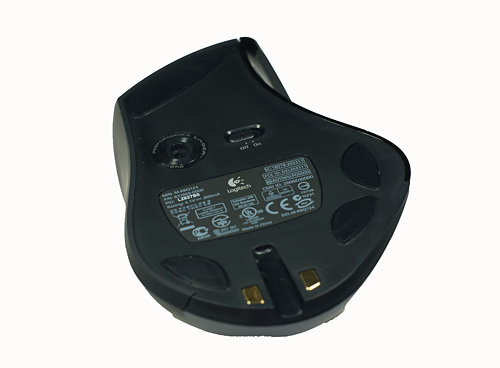
The bottom of the MX Revolution is fairly ordinary. There are four low-friction polytetrafluoroethylene (Teflon based) feet designed to reduce resistance and improve gliding across most surfaces. We found the new material on the feet allowed the Revolution to glide across our mouse pad or desktop surface a lot easier than previous Logitech offerings. In fact, the difference was noticeable the first time we used the mouse. There is an on/off switch for the unit and we suggest using it for additional power savings. The last area of interest is the sensor opening for the optical sensor. Although rated at 800 dpi, which is lower than the 2000 dpi of Logitech's gaming mice, it proved to be just as accurate and flexible in everyday use. We never felt like there was a need to adjust the mouse's pointer speed and in some cases it seemed less jittery than our G5 during gaming and especially in Photoshop.
Logitech includes a sturdy stand for the mouse that doubles as the battery charging station. A small charging adapter, SetPoint software CD, and the USB 2.0 based receiver is also included in the package along with a brief instruction guide for setting up the mouse. The MX Revolution communicates wirelessly through the USB 2.0 receiver on the 2.4 GHz frequency band with an advertised range of up to 30 feet. In our testing we found the mouse worked perfectly up to 20 feet or so without lag or skips. We did manage to reach 30 feet but the operation was awkward at best with lag and jumpiness, especially when the microwave was turned on. The mouse itself is powered by an integrated Li-Ion battery, which is charged via contacts on the bottom when the mouse is placed in the mouse stand.
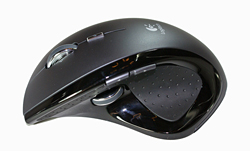 |
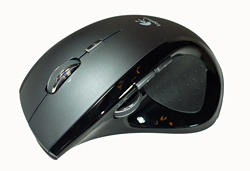 |
| Click to enlarge | |
The MX Revolution's most prominent design feature is the integrated thumb rest area. While other mice might have a similar area for the thumb or grooved recesses, the sculpted curve design of the Revolution feels perfectly natural. This entire area is molded with a rubber grip that has a nice tactile feel to it. While the number of buttons first appears to be minimal, the layout design conceals the fact that there are nine available button/wheel choices. The horizontal capable scroll wheel can be configured as three buttons (left, center, right). An additional button is located below the scroll wheel along with the two side buttons and document flip wheel, all of which are configurable. The last two are the right and left click buttons that are not configurable.
The MX Revolution weighs about the same as the MX1000 but its mass is located on the bottom side of the unit instead of up top like the MX1000. This mouse is noticeably heavier and larger than the corded gaming mice and feels like a solid chunk of expensive metal. However, the weight is not overbearing and the size of the mouse actually invokes a very comfortable feeling as we found ourselves being able to "palm" the mouse during gaming.
The revised design of the Revolution allowed our hands to fit comfortably and at times it seemed as if the mouse was tailored to our hand measurements. However, those with larger hands might find the thumb rest area to be slightly small and will have their thumbs pressed against the side wheel. We thought this would be an issue at first glance as the ability to accidentally click on this wheel could be a problem. It turned out not to be a worry as the side wheel requires a firm click or forward/backward movement to operate it. The two buttons located just above the thumb wheel are easy to access. They are just high enough to keep your thumb from accidentally clicking on them but close enough that a quick upwards flick of your thumb will operate both buttons.
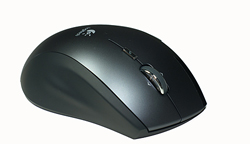 |
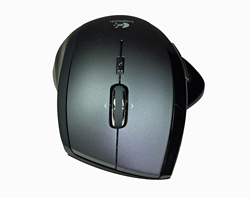 |
| Click to enlarge | |
The right side of the mouse has a slight indentation that allows the third finger to rest comfortably and allows for precise movements with the mouse. This side of the mouse is not coated with the same rubber but the plastic is molded to allow for a very comfortable feel that still has a slight grip to it. The forward section of the MX Revolution containing the right and left click buttons is sloped dramatically but its design ensures a relaxing position for the hand. The tactile feedback when clicking the right and left buttons were almost perfect in our opinion. It is obvious that Logitech placed an enormous amount of thought into the new shape, quality of materials, and overall mechanical operation of the mouse.

The bottom of the MX Revolution is fairly ordinary. There are four low-friction polytetrafluoroethylene (Teflon based) feet designed to reduce resistance and improve gliding across most surfaces. We found the new material on the feet allowed the Revolution to glide across our mouse pad or desktop surface a lot easier than previous Logitech offerings. In fact, the difference was noticeable the first time we used the mouse. There is an on/off switch for the unit and we suggest using it for additional power savings. The last area of interest is the sensor opening for the optical sensor. Although rated at 800 dpi, which is lower than the 2000 dpi of Logitech's gaming mice, it proved to be just as accurate and flexible in everyday use. We never felt like there was a need to adjust the mouse's pointer speed and in some cases it seemed less jittery than our G5 during gaming and especially in Photoshop.
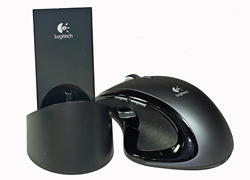 |
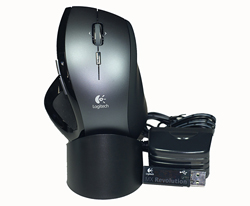 |
| Click to enlarge | |
Logitech includes a sturdy stand for the mouse that doubles as the battery charging station. A small charging adapter, SetPoint software CD, and the USB 2.0 based receiver is also included in the package along with a brief instruction guide for setting up the mouse. The MX Revolution communicates wirelessly through the USB 2.0 receiver on the 2.4 GHz frequency band with an advertised range of up to 30 feet. In our testing we found the mouse worked perfectly up to 20 feet or so without lag or skips. We did manage to reach 30 feet but the operation was awkward at best with lag and jumpiness, especially when the microwave was turned on. The mouse itself is powered by an integrated Li-Ion battery, which is charged via contacts on the bottom when the mouse is placed in the mouse stand.










38 Comments
View All Comments
GokieKS - Tuesday, October 3, 2006 - link
Any insights on the matter? =)Gary Key - Friday, October 6, 2006 - link
I could not get the side scroll to bind properly. I tried uberoptions and it appeared to work at first, then the wheel stopped working. I have a call into Logitech to see if they have any insight into the matter.GokieKS - Friday, October 6, 2006 - link
Ah, OK. Thanks so much for testing this out. =)JustAnAverageGuy - Thursday, September 28, 2006 - link
It's nice to see Logitech is going back to the two side button design. I can't stand the fact that both the G5 and G7 only have one side button. It's one of the few reasons I'm still holding onto my MX700 :)- JaAG
teng029 - Thursday, September 28, 2006 - link
i use nothing but logitech mice, but i have to say i'm not a fan of the revolution. i bought this mouse and ended up having to return it because it was uncomfortable to hold. the area where the thumb sits is curves a lot deeper than the mx-1000 that i couldn't get used to it. where the review states that the design has a natural feel to it; in my case, it was the exact opposite.Gary Key - Thursday, September 28, 2006 - link
I should probably add a statement that it is best to run down to a store that has open display items and try the feel of the mouse before buying it. We really liked the Revolution while a couple of us did not like the feel of the MX-1000. It is a matter of personal tastes which makes reviewing an item like this very subjective. :)
Spacecomber - Thursday, September 28, 2006 - link
For those of us who tend to be a bit leery wireless mice, what sort of period of steady use can you expect from this mouse's battery? And, how long does it take to charge it back up to full strength? Does the fact that this mouse shares the busy 2.4GHz spectrum pose any potential problem for those who are running a wireless network?Just wondering. I enjoyed the review.
LoneWolf15 - Thursday, September 28, 2006 - link
I have the MX Revolution's predecessor, the MX-1000. Battery life is about a week on a charge if you use it regularly, and the mouse has excellent power-saving abilities, so it shuts off quickly if you're not constantly using it and sleeps until you start again. The battery gauge is very intuitive (three bars, two bars, one bar, one red bar instead of green), and it only takes a few hours of charge to bring it from flat to full.It has no effect whatsoever on my 11.g-turbo wifi network. I really like mine, and would find it hard to switch back. My reason for not upgrading would probably be that the MX-1000 still supports both USB and PS/2, and since I have a KVM switch that is PS/2, it works out well for controlling multiple computers. That, and it was a Christmas present from my wife. ;)
mostlyprudent - Thursday, September 28, 2006 - link
"Speaking of battery strength, we noticed the mouse should last about seven to ten days on a single charge during normal usage." (page 5)mostlyprudent - Thursday, September 28, 2006 - link
Gary,You say it's the world's most advanced mouse but not the world's best mouse...yet. Do you have an opinion as to which mouse is the world's best? If so, I'ld love to hear it.